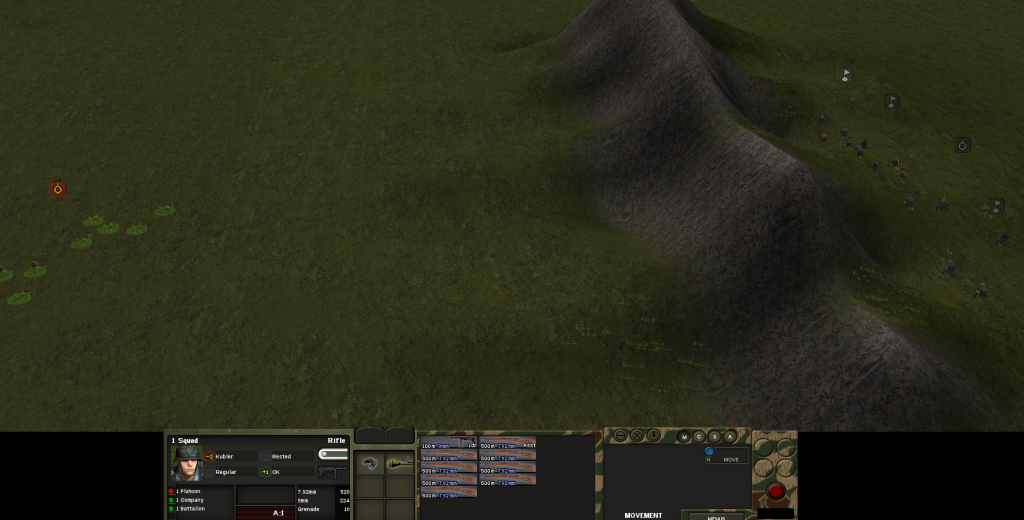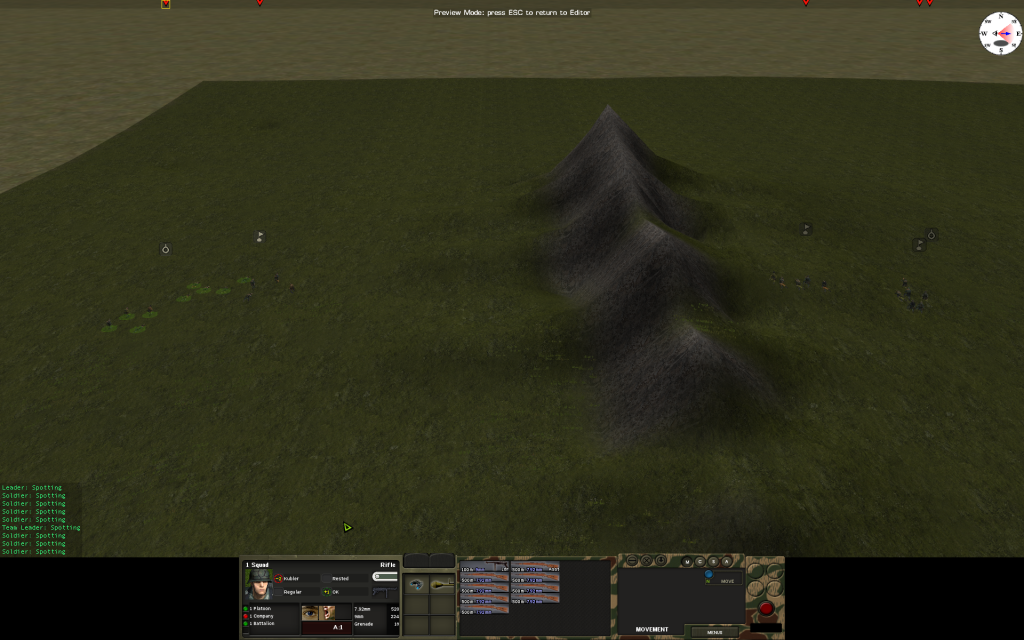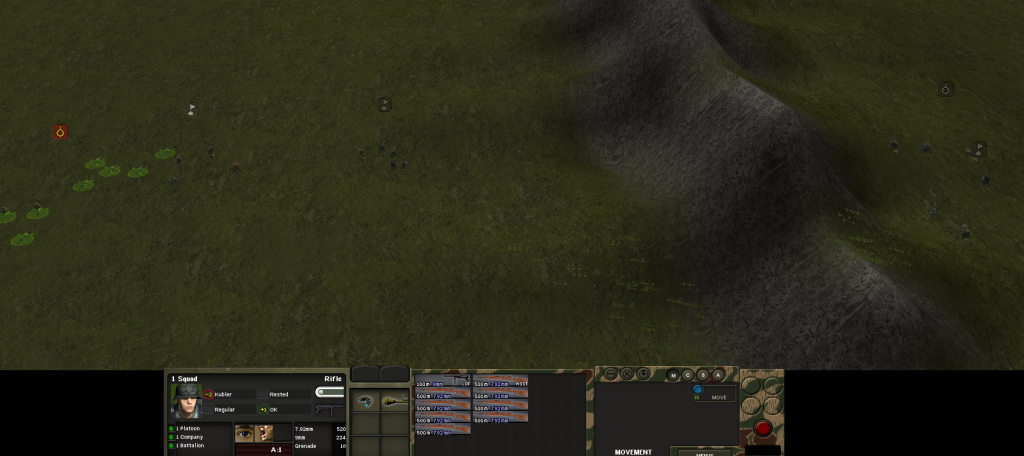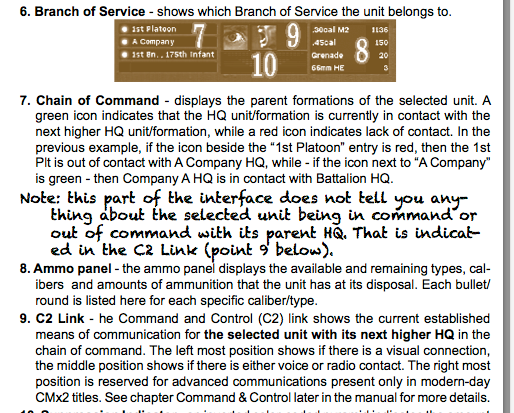-
Posts
411 -
Joined
-
Last visited
Posts posted by kensal
-
-
A tantalising glimpse of part of a dead horse, and a nice well too.
What a tease!
-
I suppose part of the answer for Bulge might lie in the fact that making it a standalone game means that new purchasers do not need to have bought Normandy as a base game in order to play it.
That might be a fair outcome for new purchasers who never bought Normandy and don't want to, but want Bulge.
Rightly though the question for people who have bought Normandy, CW and MG and pay to upgrade that to ver 3.0 when it comes out, is what Bulge will offer in terms of new content. Seems to me it is, compared to what Normandy offered in content, somewhat limited:
Autumn and winter weathers and terrains
New maps
Volksgrenadiers
Belgian and German building models
A limited amount of new vehicle types
Err...
There's probably lots more in reality but for an existing customer, it seems more like material for a further module as opposed to a whole new game.
-
It is obvious why fast and quick commands result in tired troops. It is less clear to me why the hunt command has the same effect?
-
Hi,
Soviet : German casualty ratios were a lot closer than many like to believe by ’44. If you upgrade Soviet ’44 losses to account for Forgotten Battles and discharged due to disability and sickness you get a figure of 2,738,000. German losses for Nov’43 to Nov’44, counting the same way... including disabled due to wounds you get 2,100,000. Scarily close given that the Soviet Front Armies were three times the size. German frontline units were suffering far higher attrition rates than Soviet units, on average, from about August ’43 onwards. German frontline officers, NCOs and men of all ranks had on “average..” a far shorter shelf life than their Soviet opponents. From mid ’43 onwards.
Mawdsley's Thunder in the East (Hodder 2005) quotes slightly different figures, albeit the methodology is different, so they both could be right:
Having noted the difficulty of statistical accuracy and differences in methodology, he gives German losses in the East for the period 1 October 1943 to 31 December 1944 as being 1,403,000 deaths (including subsequent deaths amongst prisoners), compared to 2,354,000 Soviet casualties, including prisoners (the majority of whom also died later). He notes that the third quarter of 1944 i.e. July-September 1994, during operation Bagration and its follow up, was the only quarter in the entire war on the Eastern front when German losses exceeded Soviet losses, by 518,000 to 511,000.
For the period from June 1941 to 30 September 1943 (2 years and 3 months) he gives 1,339,000 German deaths (including those who died in captivity) compared to 8,119,000 Soviet casualties, (including over 3,000,000 prisoners who died in captivity).
It is clear that the Soviets managed to change the loss ratio from the extremely disadvantageous in 1941 and 1942 to very disadvantageous throughout 1943 to disadvantageous in the first half of 1944 to nearly (but not quite) equality in the second half of 1944.
They managed to do that by playing to their strengths which meant in mid 1944 smashing a section of the German front with such overwhelming forces and overwhelming follow up forces, that the German defenders could not retreat and could be destroyed in much larger numbers than had previously been possible.
I am not sure though it is correct to characterise German units generally suffering much higher attrition rates than Soviet units across the whole Eastern front during this period - from mid-1943 to June 1944 Army Group Centre did not suffer a great deal of attrition as most of the fighting involved the southern army groups. However it was pretty much wholly destroyed in the space of 2 months from June 1944. Attrition isn't really the word...
-
Not to mention the fact that the Soviets were on the strategic offensive for this entire period. Assuming equally capable opponents (which is clearly not the case here), you would normally expect the attacking side to take higher casualties in exchange for gaining territory.
Actually the opposite is correct - a successful attacking force with local superiority will often inflict higher casualties on the unsuccessful defender. Furthermore more of an unsuccessful defender's casualties will be permanent missing in action (either WIA becoming KIA because unable to retreat or becoming prisoners) than the successful attacker's casualties, the WIA of which are more likely to be picked up, treated and returned eventually to the colours
-
SPOILERS
Arpella
The briefing you get is, I suppose, deliberately misleading, so as to give an element of surprise for the assault over the bridge by what is indeed intended to represent the assault over the Arnhem road bridge by the Aufklarungs Abteilung of 9SS commanded by Paul Grabner.
There is however a clue in the title - All Round Defence, and the briefing to the extent that it recommends guarding against all potential avenues of attack.
The purpose of that is presumably to ensure that you do not unrealistically put all your forces facing the road bridge giving no chance to the attackers.
The scenario is only listed to last 15 minutes - which you should see from the scenario selection window. Did your game stop earlier than that? It might have done if all the German forces had come across the bridge and either been destroyed or exited the map.
The German objective is to get its forces across the bridge and away rather than stand and fight so that it why it may have ended sooner. If you drew it may have been because too many German vehicles reached the other side of the bridge and got away.
As a criticism of the scenario the briefing might encourage a player to spend quite some time in setting up a detailed and full perimeter defence for the whole of the para battalion, only for the game to last 15 minutes and not involve 3/4 of the forces you have spent time in deploying. It is, also, if you do defend against a forced crossing of the bridge, very once sided - I noticed when running through it that I lost more men to piat bombs overshooting their targets and hitting my men on the other side of the bridge.
On the whole I think the briefing might have warned that the scenario is very short and that players should therefore take that into account in determining how much time they spend in organising their "all round defence".
As for vehicles melting into each other - they tend to do that a bit when you get a crowd of them moving around the same area, particularly if they are under fire. It is not a great graphic representation but insofar as the vehicles' ability to move it may not be inaccurate given the effect of incoming fire, smoke, panicking drivers etc.
-
I have signed up for Boldness be my brother
-
I fire my flamethrower this turn... you will want to stay tuned for that, I will post a movie.

Gurn dribble
-
No Maus, so no Ratte.

Some people just now how to spoil your day...

-
This thread is making me very curious to play the offensive half of this scenario once our game is over, Kensal. Having suffered under the weight of your assault I feel it must be possible for the Yanks to win this one.
If you feel like you've been bad and deserve to be punished for wrongs committed in a past life, A Temple to Mars is a good place to start.
Anyhow I'm not sure the US can win the way I've been going about things - hint: I'm not totally spent yet. One of the really depressing aspects I've noticed about fighting up a steep slope is watching (a) your small arms fire shooting harmlessly up into the air (
 your artillery fire landing on the far side of the hill.
your artillery fire landing on the far side of the hill. If I had to play this scenario again (if for example I had been a really really bad person in another life) I would be much slower to commit large forces into an attack. As the US player you get a whole regt to deploy in the first quarter and it is very tempting to think - well I'll put this battalion up this hill and overwhelm the defenders because I've got another two battalions behind. However that creates unmissable targets for the German mortars which are absolutely devastating. Then every second German is carrying an MG42 -literally.
I am cringing each time I open a new file and click replay to see what fresh awfulness awaits..

-
From the German side the possibilities for formations are almost endless and perhaps unrealistic to expect them all.
LW and Fallschirmjager
SS + Heer Gebirgsjager
Jager
Volksgrenadier
Volksturm (already mentioned I think)
SS Cavalry (perhaps we will have to accept that there won't be horses...)
Ski-Jager
Stellung division
Finns
Baltic States SS
Hungarians
Romanians
Bulgarians
SS Cossacks
Russian Liberation Army?
Also might it be possible for the Unit editor to have more flexibility for German forces (and perhaps US forces in Bulge) to have mixed kampfgruppe or Combat Commands? At present we can create a mixed kampfgruppe with a unified HQ by adding various single vehicles or teams to battalion HQ. It would be great to be able to add subordinate company or platoon sized formations to a battalion HQ - say a PzGr or infantry Battalion HQ with a subordinate armoured company or platoon HQ
-
It's the AI group to which the unit highlighted belongs (all units default to A:1)
This info only shows in scenario author mode and in effect is a design tool to link on screen units to AI plans.
P
Yes I took the screen shot from the deploy unit screen in the scenario editor
-
True they were brutal and fanatic. But tell me: which revolutionaries are not? How could have Hitler achieved his impossible mission without being a fanatic and accumulating other fanatics? How less brutal or fanatic are politicians that drop atomic bombs? Or wage wars "to defend" their values?
How intolerant are politicians that do not accept that there are different forms of government in this world?
Isn't fanaticism and brutality a prerequisite to even accept a suitcase with the codes for a nuclear war?
What about the extintion of the Incas by the Christians or Spaniards? Or the native Americans? Or slavery? Not fanaticism and brutality?
Are politicians not brutal and fanatic if they sponsor terrorists to destabilize and gain control over a country?
And that, despite the fact, that the whole ideology of Nationalscialism is not about claiming to be pacifistic, or bring peace to the world, while most of the other ideologies do exactly that.
As an ideology it very much reminds me of what Braveheart says, when his wife is threatened: I don't care about your right about primae noctis, I take my right as husband.
IMO any discussion about moral values should have no place in a discussion where it's about to understand history. In most cases the moral arguments are only used to cover rationale intentions.
To me it seems, the more a rulership is built on lies, the more TPTB will use the moral "arguments" (often with the help of "black propaganda"), because the honest facts just do not support their political position.
If someone wants to make me believe any government or politician was acting because of being simply evil, and I do NOT need to go back in time!, then I almost always find profound economic and pecuniary interests behind the story.
When one thinks about it, it's very logical: people everywhere in the world do not support wars of their politicians for the enrichement of the rich or for usurpation of unjustified power. Therefore it is always important for these forces, to make people believe the intervention was for other noble moral reasons. People must be kept aways from looking at the hard facts. And what works better than turning the other side into criminal and evil? Who is interested to be the laywer of a murderer, a sadist? I believe that's how it works.
Hitler's and the Nazi party's policies as to aggressive war, genocide and the subjugation of other countries and peoples were deliberate and planned. He and they deliberately planned and carried out a policy to destroy Jews, Roma, and people they defined as degenerate or mentally deficient. He and they planned and attempted to carry out a war in Russia the ultimate and accepted by-product of which was to be the death by starvation of the majority of the urban population of the European Soviet Union.
None of the purported comparisons you provide, however wrong or immoral they were, are in fact adequate comparators.
The effect of the expansion of white immigrants on Native North Americans was, however casually brutal, neither planned nor systematic nor deliberately genocidal. The same can be said about the Spanish and Portuguese exploitation of Central and South America or, on fact, any other colonial situation except possibly King Leopold's governance of Congo or certain aspects of British treatment of aboriginal peoples in Australia and Tasmania. But even in those places there was no planned element comparable to the Nazis' efforts in Central and Eastern Europe in the first half of the 1940s.
The only real comparables are the other dictatorships which you presumably would equate with these examples - such as Stalin, Mao and Pol Pot.
None of what you say stands up to even limited scrutiny.
-
Very confusing.
I always thought the indicator besides the Platoon HQ indicates two things, depending on which unit is selected:
If the platoon HQ is selected it displays C2 platoon HQ to the company.
But if a squad is selected, it displays the C2 from the squad to the platoon HQ.
I think it would be less confusing, if there would be a dedicated additional field for C2 of squads/teams, additionally to the eye/shout/gesture indicator.
That is what it does show. The problem is that the manual states, wrongly, it seems, that it shows something else. The game engine 3.0 contains, if I understand right, command lines between units on the map and that should give a clearer picture.
-
Steve, thanks for looking in on this and picking it up: can I suggest that, along with the text change itself, the order of explanation is changed to read more left to right across this section, and - say - paras 8 and 9 have their numbers and order swapped, so that the C2 link explanation immediately follows the chain of command explanation (and as the interface shows them, next to one another).
The split of the them was for me part of the problem in the current manual.
Thanks Kensal for prompting this.
No credit to me for that - I was simply following up James Crowley's post no 136 in the Soviet AAR thread
-
Yeah, that should read:
in the previous example, if the icon next to "1st Platoon" is red then it is out of contact with "A Company".
Ermm I think that's what it says now. I think it needs to read as per the suggestion in my previous post!
-
What UI mods you using there Kensal?
Thanks
-F
Juju's UI mod and Marco Bergman's weapon slots. Normally have Mord's portraits as well but didn't load a selection for this test
-
I think I see the point of confusion. Looks like we should simply remove this section:
"NOTE - this part of the interface..."
I think this is an example of the game having worked one way and then another, but the instructions weren't updated. I'll see that it gets fixed.
Thanks!
Steve
I think you need to amend the third sentence in para 7. too - to "in the previous example, if the icon next to "1st Platoon" is red, then the selected unit is out of contact with 1st Platoon HQ while if the icon next to "A Company" is green then 1st Platoon HQ is in contact with A Company HQ
-
However, now look at these four shots. A German sicherungs battalion, with 1 company, 1 platoon, 1 squad. There is a rather sharp mountainous ridge in the middle:

In the above image, 1 squad is out of contact with 1 platoon hq, the ridge intervening. The green/red C2 icon against 1 platoon on 1 squad's UI is red, indicating this.
1 platoon hq, (highlighted), is right next to 1 company hq on the other side of the ridge. 1 platoon is shown to be in contact with 1 company, with a green icon against 1 company on 1 squad's UI. 1 battalion hq is also right next to 1 company hq and is noted as in contact by the green icon against 1 battalion on 1 squad's UI.

In the above image, 1 platoon hq (highlighted) is now right next to 1 squad. 1 squad is in C2 with 1 platoon. The icon against 1 platoon is green and the eye and voice icons are filled. However, 1 platoon hq, which has no radio, is shown as being out of C2 with 1 company on the other side of the ridge, by the red icon against 1 company in 1 squad's UI.

The above image is the same situation as before but with 1 platoon hq selected. No radio, so no C2 with 1 company.

In this final image above, 1 company hq has now moved back next to 1 platoon hq. 1 company has a radio (as does 1 battalion). Accordingly, with 1 squad selected, its UI is now showing that it is still in C2 with 1 platoon (as it was in the previous two frames, with a green icon against 1 platoon, but now 1 platoon hq is in contact with 1 company, 1 company having moved right next to it. 1 company remains in C2 with 1 battalion because it and 1 battalion have radios.
I think the manual ought to be amended because it does seem to be saying something completely different to what is happening on the ground.
-
Page 29 of the manual covers the user interface for C2. It says:

If you look at the third sentence of para 7, it says "In the previous example, if the icon beside the "1st Platoon" entry is red, then the 1st Plt is out of contact with A Compay HQ..."
Then the manuscript note tells you that this part of the interface does not tell you anything about the selected unit being in C2 - that is indicated in the C2 link (point 9 below)
Point 9 tells you to look at the eye and voice icons as to whether your selected unit is in C2. In this example it is because it has eyes and ears on 1st Platoon as indicated by the two icons.
-
I had always thought (partly because I believe what I read in the manual ...
 ) that the answer to this was "yes": so that, for example, to be able to call in higher level off map artillery that would not be part of the structure of the on-map units, there must be an off-the-map C2 link to assets that are controlled by the brigade / regiment?
) that the answer to this was "yes": so that, for example, to be able to call in higher level off map artillery that would not be part of the structure of the on-map units, there must be an off-the-map C2 link to assets that are controlled by the brigade / regiment?I've done a quick test on this which suggests that the manual is wrong and that the platoon icon on a squad C2 indicator is telling us whether the squad is in C2 with its platoon, rather than the platoon being in C2 with its Company.
I'll put the images on another thread so as not to disrupt this thread
-
Quick comment:
This mildly annoys me, in terms of CM's depiction of CAS. Almost all CAS missions flown on all sides involved several aircraft fighting as a unit, not one pilot signing his own death warrant by flying repeated, low-level attack runs over a single target-area. I would far rather CM modelled CAS by having at least 4-8 aircraft turn up at once, strike the map in one or maybe two turns' worth of attacks and then vacate the area before AAA is fully awake and/or they're spotted by an enemy fighter patrol. Think 30 seconds of a hellish cacophony of pistons, gunfire and ordnance and then the fast diminishing sound of pilots jinking their way to safer airspace.
I agree with this. Other than during the last stages of the Falaise pocket I think it is fairly unlikely that pilots would have been carrying out several strafing runs in the same area
-
But that (my bold bit of your quote above) is not what the manual says ... as Jim said in his post, the manual says that the green light against 1st Platoon when the SQUAD is the selected unit means that the 1st Platoon (not the Squad) is in contact with ITS HQ: the contact status of the squad itself with 1st Platoon is indicated by the presence or absence of the contact method icons (eye, voice, etc) in the Squad's panel?
Confuses me too, in that what seems to be happening (e.g. with keeping mortar teams in contact) does not always seem to follow what the manual says ...
The other issue that is confusing about this is that on the basis set out in the manual, the icon next to the battalion hq does not indicate 5 Coy's status vis a vis Battalion but rather Battalion's status vis a vis brigade / regt. But aren't Battalion HQs the highest level of command in the game? Or is there an off-map higher level of command which a battalion can be in or out of command with depending on whether it still has its radio man?
-
Just a thought but I think the board might benefit if CMBN, CMFI and CMRT were combined, so that there would be one general board, and one Mods board and one tech support board.



Foxholes and Trenches
in Combat Mission Red Thunder
Posted
One issue that I am not clear on - a team in an action spot containing foxholes may or may not all be sitting in the foxholes - quite often if the foxholes are adjacent to a hedge line, and they are given a face order towards the hedge, they congregate in the corner of the action spot next to the hedge, and are not actually represented as being in the foxholes.
In this position I believe (but would like to be sure) that they are not in fact protected by the foxholes. In order to be protected by the foxholes they have to be actually represented as sitting in them.
Can someone clarify if this is right?